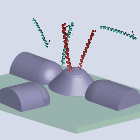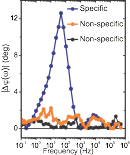Biomolecular Electronics Group
Dr Steven Johnson
Biomolecular Electronics Group
Dr Steven Johnson

Our understanding of biological science is based predominately on many decades of study on large ensembles of molecules. Bioscience today has become increasingly focused on the properties and function of individual biomolecules. The earliest demonstration of a single molecule experiment emerged from a union of electronics with biology that enabled the conductance of a single transmembrane ion channel to be measured.
We have shown recently that a perturbation of a molecular layer formed on an electrode, for example a change in molecular conformation or the formation of a protein-ligand complex, can be detected electronically through measurements of the electrochemical impedance. However, direct electrochemical impedance measurements are limited in sensitivity and restricted to measurements of the average response of molecular ensembles. In order to interrogate biomolecular function at the single molecule level, it is necessary to adopt alternative electronic technology in which conductance is critically and sensitively dependent on the system impedance.
Single electron transistors (SETs) are reminiscent of field-effect transistors – the basis of all modern electronics – but SET conductivity can be modulated by several orders of magnitude upon the addition of just a single electron. Our commercial partner, Hitachi Cambridge Laboratory Ltd, have pioneered the design and characterisation of SETs that can be fabricated using conventional CMOS compatible processing. Critically, they act as highly sensitive detectors of charge, and accordingly impedance, with sub-single electron charge sensitivity. This extremely high sensitivity to the local environment coupled with comparable size between the SET and many biological macromolecules (SET diameter typically <50 nm compared to around 14 nm for long axis of IgG), opens the possibility of label-free electronic detection at the single molecule level. Furthermore, they can be assembled in high-density arrays and designed to operate on microsecond time enabling multiplexed bioanalysis with high temporal resolution. This highly interdisciplinary programme will investigate approaches for integrating molecular biology with SETs in order to demonstrate in-vitro detection of biochemical activity at the single molecule level.



Hitachi Cambridge Laboratory

